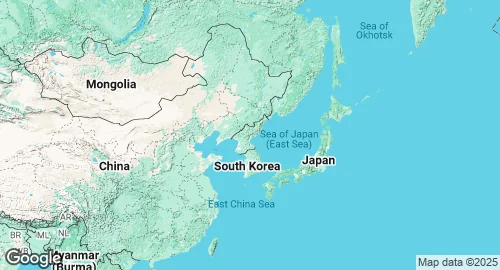North Korea Military Forces 🇰🇵
Military Strength Overview
| 🛩️ Air Force | 861 active aircraft |
| ⚓️ Naval forces |
385 ships in fleet
– incl. 73 submarines |
| ☢️ Nuclear Arsenal | 50 warheads |
| 🪖 Active Troops | 1,280,000 personnels |
| ⛑️ Reserve Troops | 600,000 personnels |
| 👮♀️ Paramilitary | 5,700,000 personnels |
| 🎖️ Military ranks | 64 ranks listed |
Defense Statistics & Key Metrics
| Population | 25.9 million (2018) |
| Military Budget | $1.6 billion (2018) |
| Military spends per capita | $62 (2018) |
| Military Personnel | 1,469,000 (2018) |
Strategic Overview in 2025
North Korea’s military, the Korean People's Army (KPA), is a cornerstone of state power and national identity. Its primary mission is regime survival, deterring any external intervention, and enabling Pyongyang’s coercive diplomacy. The KPA’s strategic posture is defined by a massive conventional force, a growing and increasingly sophisticated nuclear arsenal, and a forward-deployed military presence along the Demilitarized Zone (DMZ).
Military Forces
The KPA is one of the world's largest military organizations, with approximately 1.3 million active personnel and a vast reserve force of over 6 million. Military service is a constitutional duty for all citizens. The KPA is divided into five branches: the Ground Force, Naval Force, Air Force, Strategic Force, and Special Operations Forces.
The Ground Force is numerically significant, possessing thousands of tanks, armored vehicles, and artillery pieces. A substantial portion of this artillery is positioned near the DMZ, capable of striking Seoul, a capability often referred to as the "sea of fire" threat. The Navy operates a large submarine fleet, primarily composed of smaller coastal vessels. The Air Force is sizable but relies heavily on outdated Soviet-era and Chinese-made aircraft.
Pyongyang’s defense industry is geared towards self-sufficiency, producing a range of indigenous equipment from small arms to ballistic missiles and submarines. However, this self-reliance comes at the cost of technological sophistication, and much of its conventional hardware is aging.
Strategic Trends
The most significant strategic trend is North Korea's expanding nuclear weapons program. Estimates suggest the country may possess enough fissile material for over one hundred nuclear weapons and has developed ballistic missiles capable of reaching the United States. This nuclear capability is the ultimate guarantor of regime security and serves as a shield for its conventional provocations.
Economically, North Korea dedicates a substantial portion of its GDP, estimated at nearly a quarter, to military spending. This “military-first” policy, however, has led to severe resource constraints and a stark contrast between its advanced missile programs and its aging conventional forces.
Regionally, North Korea remains a persistent security challenge. Its military provocations and weapons testing destabilize the Korean Peninsula and create dilemmas for the United States and its allies, South Korea and Japan. The KPA’s sheer size and forward deployment ensure that any conflict on the peninsula would be catastrophic, a reality that underpins its deterrence strategy. While its conventional forces face modernization challenges, the combination of a massive, dug-in army and a growing nuclear arsenal makes North Korea a formidable and unpredictable military power.
North Korean Military Budget History
Population and Military Personnel Trends
GDP and Inflation Rate Trends
Military Expenditure: SIPRI Milex.
